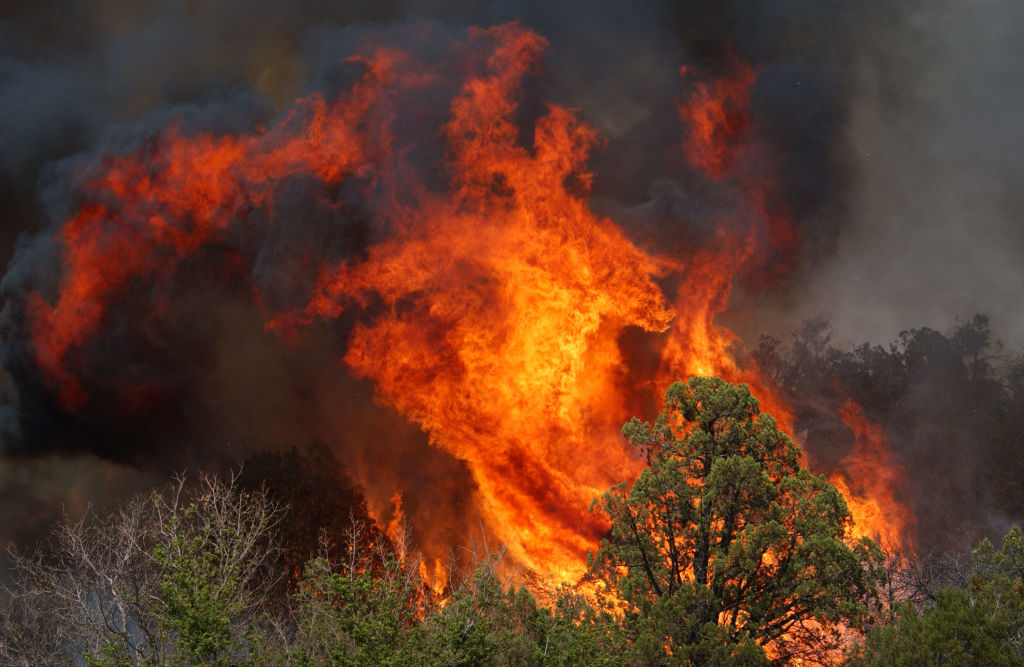Flagstaff residents evacuated near wind-whipped Arizona wildfire
Apr 19, 2022, 6:52 PM | Updated: Jun 13, 2022, 3:35 pm

CIBECUE, AZ - JUNE 28: Flames of the Rodeo/Chediski fire consumes the forest June 28, 2002 on the Fort Apache Indian Reservation near Cibecue, Arizona. Sixty percent of the fire is on the Apache reservation which relies heavily on its rich ponderosa pine forests for logging, hunting, and tourism. The intensity of the fire has devastated the pines and threatens the tribe's economic well-being. The Rodeo/Chediski fire, the biggest fire in Arizona history, is only 10 percent contained. (Photo by David McNew/Getty Images)
(Photo by David McNew/Getty Images)
FLAGSTAFF, Ariz. (AP) — A fast-moving wildfire in rural northern Arizona ballooned to over 9 square miles Tuesday as winds whipped the flames, shut down a major highway and grounded aircraft that could drop water and fire retardant.
About a couple hundred homes along U.S. 89, north of Flagstaff, were evacuated as embers jumped ahead of the main blaze and smoke billowed into the air in an all-too familiar scene. Residents recalled scrambling to pack their bags and flee a dozen years ago during another wildfire that burned for days in the same area.
Firefighters on Tuesday were up against 50 mph (80 kph) gusts that pushed the wildfire over the highway and weren’t expected to let up much this week, authorities said.
“It’s blowing hard, and we have ash falling on the highway,” said Coconino County sheriff’s spokesman Jon Paxton.
A top-level fire management team is expected to take over the wildfire later this week.
Fire and law enforcement agencies that were knocking on doors to warn of evacuations Tuesday were forced to pull out to avoid getting trapped by the flames, Paxton said. Arizona Public Service Co. shut off power to about 625 customers to keep firefighters safe, a spokeswoman said.
Hotter and drier weather coupled with decades of fire suppression have contributed to an increase in wildfire activity, fire scientists say. The problem is exacerbated by a more than 20-year megadrought in the U.S. that studies link to human-caused climate change.
Red flag warnings blanketed much of Arizona and New Mexico on Tuesday, indicating conditions are ripe for wildfires. Residents in northern New Mexico’s Mora and San Miguel counties were warned to be ready to evacuate as wildfires burned there amid dry, warm and windy conditions.
The National Interagency Fire Center reported Tuesday that nearly 2,000 wildland firefighters and support personnel were assigned to more than a dozen large wildfires in the Southwestern, Southern and Rocky Mountain areas.
The fire in Flagstaff was estimated at 100 acres (40 hectares) early Tuesday but quickly grew to 9.3 square miles (24 square kilometers), scorching timber and grass. It started Sunday afternoon 14 miles (22 kilometers) northeast of the city nestled in the largest, contiguous Ponderosa pine forest in the U.S. Investigators don’t know yet what caused it and have yet to corral any part of the blaze.
The Arizona Department of Transportation shut down a section of U.S. 89, the main route between Flagstaff and the far northern part of the state, and a primary route to and from Navajo Nation communities, because of the wildfire. Various organizations worked to set up shelters for evacuees and for animals.
The wind is expected to be a challenge the rest of the week, along with warmer-than-average weather and low humidity, the National Weather Service said.
“I don’t see any significant decreases in wind, I don’t see any big bump ups in humidity and, at this point, we’re not really expecting any precipitation either,” said meteorologist Robert Rickey.
About 200 firefighters were working the fire that appeared to be moving to the northeast toward Sunset Crater Volcano National Monument and volcanic cinders, said Coconino National Forest spokesman Brady Smith.
“It’s good in that it’s not headed toward a very populated area, and it’s headed toward less fuel,” he said. “But depending on the intensity of the fire, fire can still move across cinders.”
Elsewhere in Arizona, firefighters battled a wildfire in a sparsely populated area of the Prescott National Forest about 10 miles (16 kilometers) south of Prescott. The cause of the 600-acre (2.4 square-kilometer) wildfire was under investigation.
Some communities were evacuated and a shelter set up at Yavapai College.
In southern Arizona, a principal highway route between Bisbee and Sierra Vista reopened Tuesday after being closed for about eight hours overnight due to a brush fire in the hills overlooking Bisbee.
___
Associated Press writer Paul Davenport in Phoenix and Susan Montoya Bryan in Albuquerque, New Mexico, contributed to this report.













